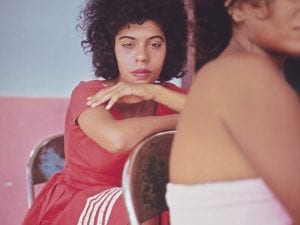Text by Asana Greenstreet
People are always wishing, hoping for some sort of transformative experience from art. Gazing at a Gainsborough is all well and good, transporting the viewer back through two centuries of history. But what ought we to do when an artist takes us on a journey that we are uncomfortable with? At Modern Art Oxford, walking up the stairs strangely makes the visitor focus on the time and speed of the journey: on the distance travelled vertically, towards darkness.
This fast approaching sci-fi feeling, is confirmed on entering the exhibition space: a large circular bright white seating area, and a “floating screen” playing Dawood’s Trailer (2011). A man approaches each visitor carrying two crumpled plastic microporous material pieces. And then a plunge back to earth, as the realisation of being in a gallery space – the medium itself transformed – hits home as the visitor covers their feet to take a seat on a purpose built viewing platform.
In the first room of the gallery Modern Art Oxford presents Trailer, a shorter edit of Dawood’s feature length film Piercing Brightness, to be released this year. The title urges anticipations of a cinematic experience of a short film. 15 minutes in length, Dawood pushes the average attention span to the limit until the 10 minute mark, where, despite the self-awareness of being in the gallery, all cognitive understanding of real time is lost. A testament to its formal qualities, it is possible to spend a prolonged period with the film, watching it again, in the hope of understanding it. On being questioned about the site specificity of the films’ display, exhibition organiser Melanie Pocock says the artist “is interested in what happens when objects are looked at, how they morph into being by the person who is looking”.
In expanding on the above, it is Dawood’s use of montage, various light sources, and other cinematic devices that make for an interesting attraction to the projection of the artwork. The impressive installation of both the seating arrangements and the film are to be applauded, as they add to an immersive experience of the piece.
The film Trailer ostensibly deals with real life subjects such as immigration, and identity. However, it seems the construction of any narrative that contains these themes is as much to do with the person watching the film, as they belong to the artist as the maker. This type of audience engagement with the work is interesting because, just as piercing brightness does, it conceals as much as it reveals.
The textile paintings in the middle gallery are just as thought provoking. These manage to link abstraction, geometry, calligraphy and architecture together. Using acrylic to paint on vintage textiles, Dawood creates a dream-like space located within the physical material of the cloth. What the viewer sees is never explicit; however, the convergence of cultures is easily spotted in the marriage of European and Arab inspirations. The latter appears to embody the spiritual in geometric form. This is combined with references to the great 20th century modernists such as Barbara Hepworth, Paul Nash, and perhaps even Ben Nicholson, as curator Michael Stanley indicates in the exhibition catalogue. This display is a much needed break in the exhibition’s development, though it feels a little static.
New Dream Machine Project (2011) is a film that tries to create a reverie, promoting a hypnotic feeling within the viewer. Perhaps derived from the full length screen installation, this space does have a heightened reality to it, and once again engulfing the visitor into the film. Dawood’s practice is so interesting precisely because his artworks play with the space that contains them, encouraging the viewer to become self-aware of and within their location.
Shezad Dawood doesn’t ask questions, nor does he attempt to offer answers to questions the visitor may have. Don’t ask, just give into the experience of it. Conventionally science-fiction, this exhibition is a must see, although more compelling because Dawood plays with the traditional understanding of the genre to navigate contemporary oddities, ideas and ideologies.
Shezad Dawood, Piercing Brightness, 05/04/2012 – 10/06/2012, Modern Art Oxford, 30 Pembroke Street, Oxford, OX1 1BP. www.modernartoxford.org.uk
Caption:
MASK (played by Houda Echouafni) giving orders to the aliens
Photography: Richard Harrowing





